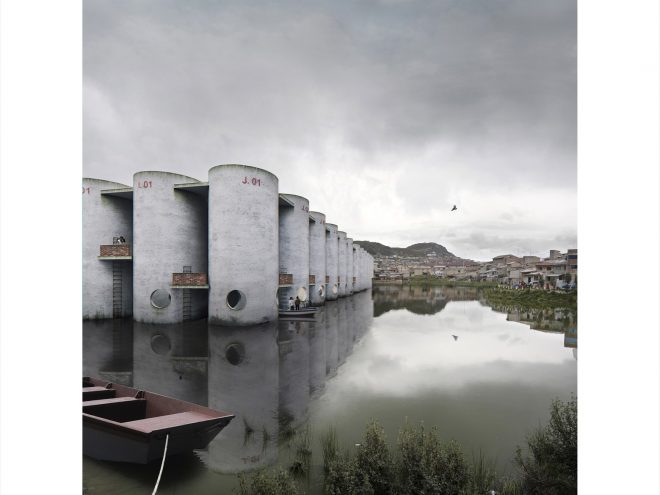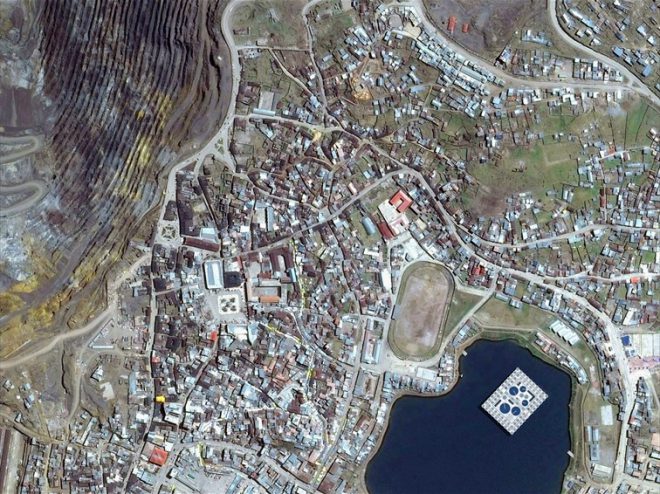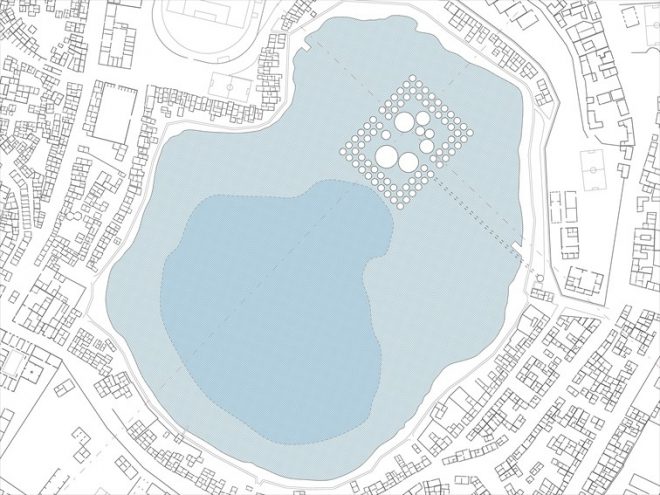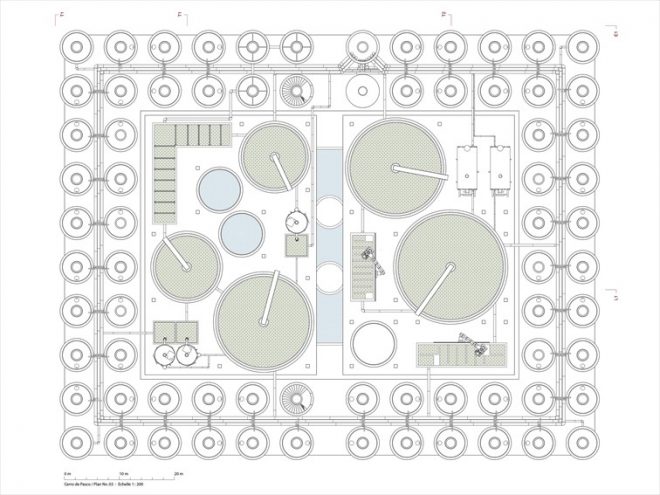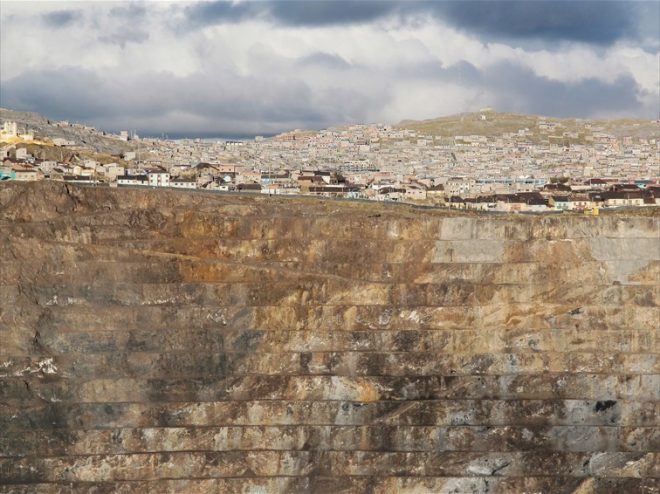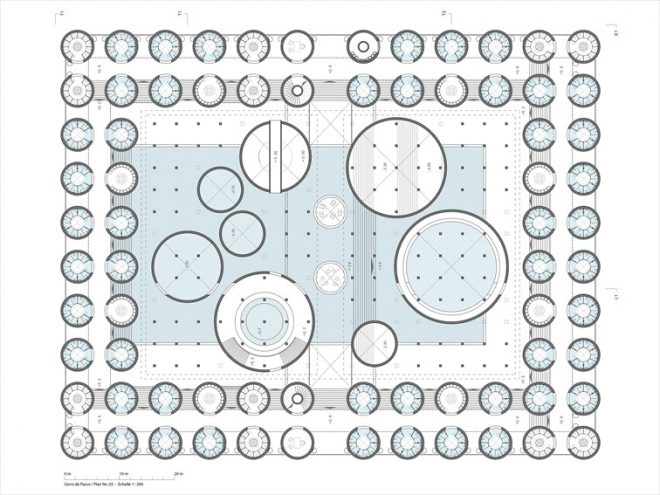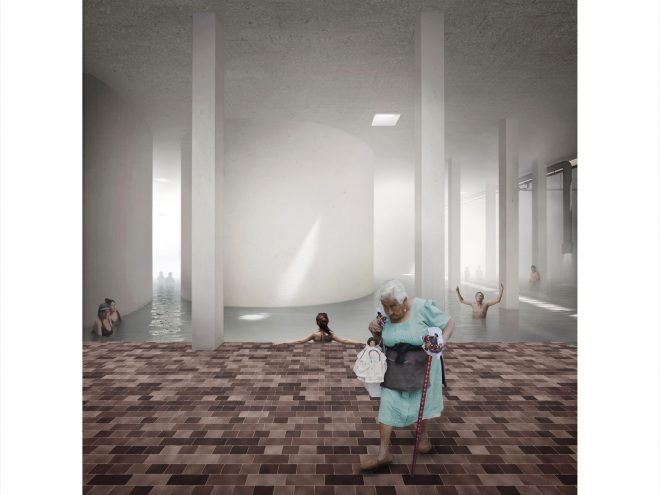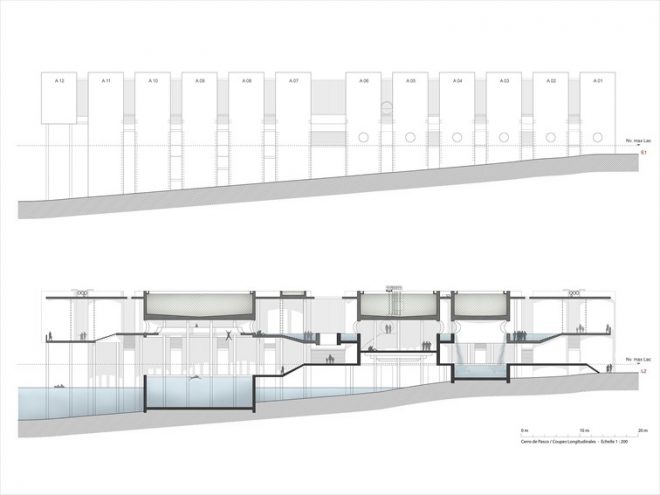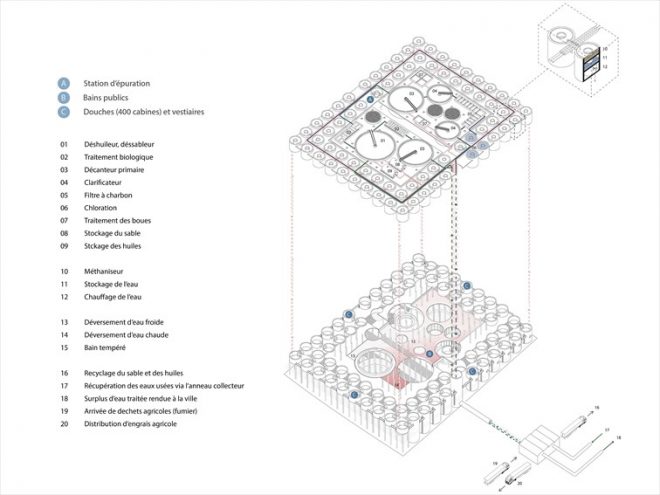Τα Διεθνή Βραβεία LafargeHolcim αναδεικνύουν έργα και ιδέες από τους κλάδους της αρχιτεκτονικής, της μηχανικής, του πολεοδομικού σχεδιασμού καθώς και της τεχνολογίας υλικών και κατασκευών, που συνδυάζουν τις αειφόρες και αποδοτικές λύσεις με την αρχιτεκτονική αριστεία. Η διοργάνωση με βραβεία ύψους 2 εκατομμυρίων δολαρίων παρέχει τη δυνατότητα υποβολής συμμετοχής σε δύο κατηγορίες, την Κύρια Κατηγορία που αναζητά κορυφαία έργα αειφόρων κατασκευών από επαγγελματίες και την κατηγορία «Επόμενη Γενιά», φοιτητές και νέοι επαγγελματίες μέχρι 30 ετών έχουν την ευκαιρία να υποβάλουν φρέσκες, τολμηρές και πρωτοποριακές ιδέες που βρίσκονται σε προκαταρκτικό στάδιο μελέτης.
Για περισσότερες πληροφορίες και δηλώσεις συμμετοχής, μπορείτε να επισκεφθείτε τη σελίδα
https://www.lafargeholcim-foundation.org/awards/6th-cycle.
Η νέα κατασκευή προσφέρει την ανάγκη στους κατοίκους να πλυθούν σε καθαρό πόσιμο νερό και βρίσκεται στην πόλη Cerro de Pasco στο Περού. Συνδυάζοντας μια μονάδα επεξεργασίας λυμάτων με λουτρά και 400 καμπίνες ντους, ο σχεδιασμός αντιμετωπίζεται ως ένα σχεδιασμένο μνημείο δίπλα στη λίμνη που ικανοποιεί τις αναγκαίες και βασικές λειτουργίες για καθαρό νερό που χρειάζονται οι κάτοικοι της πόλης. Φιλοδοξία του έργου είναι να παρέχει καθαρό νερό, αλλά και έναν διαμορφωμένο και σχεδιασμένο χώρο μπάνιου με καθαρό νερό.
Προτείνεται ένα σχέδιο υβριδικής υποδομής και κοινωνικής παρέμβασης που συνδυάζει μονάδα επεξεργασίας λυμάτων με δημόσιο λουτρό σε μια υπάρχουσα μολυσμένη λίμνη στο Cerro de Pasco του Περού. Ο κεντρικός χώρος, ο οποίος περιέχει διαφορετικούς τύπους λουτρών, διαμορφώνεται από τις καμπύλες των δεξαμενών επεξεργασίας. Απλές καμπύλες μεγεθύνουν την εμπειρία του χρήστη και σχηματοποιούν το μέρος. Σε μια πόλη γεμάτη από σύμβολα και αλληγορίες, μια συμβολική ανάγνωση αυτής της αρχιτεκτονικής δεν εξαρτάται από την εμπειρία των χρηστών, αλλά επιδεικνύει ανεπαίσθητα στους κατοίκους το δικαίωμά τους να επιδιώκουν μια καλύτερη ζωή. Αποτελεί μια αρχιτεκτονική που αποδίδει φόρο τιμής στην αξία του νερού ως συλλογικό πόρο που πρέπει να αγαπάμε.
Η αρχιτεκτονική ως ηθική θέση: μια κοινωνική απάντηση σε ένα βαθύ συμβολικό πλαίσιο
Το Cerro de Pasco, μια πόλη εξόρυξης στις Άνδεις που ιδρύθηκε τον 16ο αιώνα, έχει αναπτυχθεί σε μια πόλη που εκμεταλλεύεται κοιτάσματα ορυκτών. Από τη δεκαετία του 1950, ένα ανοικτό ανθρακωρυχείο καταβροχθίζει την πόλη. Έχει ήδη καταστρέψει ένα μεγάλο μέρος του ιστορικού κέντρου και θα συνεχίσει να αναπτύσσεται όσο η δυτική κοινωνία επεκτείνεται.
Ο συνδυασμός της βιομηχανίας και των δημόσιων λουτρών (που ήταν πάντα σύμβολα μιας πόλης μέσα στην πόλη, στη ρωμαϊκή παράδοση καθώς και στην παράδοση της Ίνκας) έχει νόημα. Είναι μια αλληγορική απάντηση στη βαθιά συμβολική μορφή της πόλης. Ο Cerro de Pasco ήταν πάντα πιο κοντά σε ένα εργοστάσιο παρά σε μια πόλη. Οι άνθρωποι ζουν μόνο εκεί για να παράγουν. Το έργο αμφισβητεί αυτό το αστικό μοντέλο. Προσφέρει μια εναλλακτική λύση στην παραγωγική πόλη.
Η αρχιτεκτονική ως οικοσύστημα: μια βιώσιμη απάντηση σε ένα βαθιά μολυσμένο περιβάλλον
Η λίμνη όπου πραγματοποιείται το έργο είναι σήμερα ο αποχετευτικός αγωγός της πόλης. Το έργο, εκτός από τον καθαρισμό του νερού για την πόλη, επιτρέπει στους χρήστες να κάνουν ζεστό ντους ή ζεστό μπάνιο. Το νερό θερμαίνεται με φυσικό αέριο, χάρη στο ολοκληρωμένο σύστημα μεθανοποίησης που χρησιμοποιεί τα απόβλητα της επεξεργασίας, καθώς και τα γεωργικά απόβλητα. Οι αγρότες μπορούν να ανταλλάσσουν τα απόβλητα τους με φυσικά λιπάσματα, που παράγονται από τη διαδικασία μεθανοποίησης. Κατά το μεγαλύτερο μέρος του έτους, το έργο μπορεί να πρόσβαση με τα πόδια, αλλά κατά τη διάρκεια των βροχερών περιόδων, η στάθμη του νερού αυξάνεται, δημιουργώντας μια άτυπη οικονομία (μεταφορά με πλοίο) για να διατηρηθεί η πρόσβαση στο κτίριο. Η τοπική αγροτική και η ανεπίσημη οικονομία ενισχύεται και η λίμνη μετατρέπεται και πάλι σε πηγή νερού για την πόλη.
Η αρχιτεκτονική ως προστασία: μια ενσυναίσθητη απάντηση σε ένα βαθιά απειλητικό πλαίσιο
Το έργο προσφέρει στους κατοίκους ένα χώρο για να πλυθούν και αποτελεί ένα ουσιαστικό βήμα προς μια πιο αξιοπρεπή ζωή. Παρέχει στον κάτοικο το δικαίωμά του να έχει πρόσβαση στο νερό, να επωφελείται από τους φυσικούς πόρους της χώρας του, οι οποίοι μονοπωλούνται από την εταιρεία εξόρυξης. Επίσης επιτρέπει στους κατοίκους να ξεφύγουν από τη καθημερινή τους ρουτίνα για μια στιγμή. Στα 4350μ., Σε μια πόλη όπου η ζωή είναι τραχύ, επιτρέπει μια στιγμή ανάπαυσης. Διασχίζοντας τη λίμνη και μετά το πάχος των ορίων του κτιρίου θα οδηγούσε σε ένα μοναδικό χώρο: μια πόλη μέσα στην πόλη – ένας τόπος όπου όλες οι αισθήσεις διεγείρονται και όπου οι κοινωνικές αλληλεπιδράσεις μπορούν να επαναπροσδιοριστούν. Κόντρα στην εταιρεία εξόρυξης και το παραγωγικό της όραμα για την πόλη, το κτίριο ενσωματώνει μια συλλογική συνθήκη.
Περιφερειακή έκθεση κριτικής επιτροπής – Λατινική Αμερική
Η επιτροπή εξέτασε την ιδέα χρήσης υπολειμμάτων στερεών αποβλήτων – υποπροϊόντων επεξεργασίας λυμάτων – ως πηγή ενέργειας για τη θέρμανση του νερού που χρησιμοποιείται στο δημόσιο λουτρό. Παρόλο που σχεδιάστηκε ως μια υποδομή στη μέση ενός απειλούμενου περιβάλλοντος, το κτίριο φιλοδοξεί να είναι κάτι περισσότερο από ένα κομμάτι υποδομής, γιατί προσφέρει ένα μεγάλο κοινωνικό χώρο συγκέντρωσης εντός της πόλης, καθώς αντιμετωπίζει το νερό ως συλλογικό αγαθό και την αρχιτεκτονική ως το μέσο που αποδίδει φόρο τιμής στην αξία του νερού ως συλλογικό πόρο.
Clearwater Revival in Peru. Public baths and sewage treatment plant
The LafargeHolcim Awards seek leading projects of professionals as well as bold ideas from the Next Generation that combine sustainable construction solutions with architectural excellence. The 6th cycle of the international competition is open for entries until February 25, 2020. The Awards foreground projects and concepts from architecture, engineering, urban planning, materials science, construction technology, and related fields. Prize money totals USD 2 million.
Submit your project here!
It is proposed a hybrid infrastructure and social intervention plan that combines a public bath in a polluted lake in Cerro de Pasco, Peru. The project is combining a sewage treatment plant with a public bath in a contaminated lake in Cerro de Pasco, Peru. The project’s ambition to provide both clean water as well as a place to bathe is a response to the wasteful use of an existing resource by ruthless industrial exploitation.
Located in a contaminated body of water – formerly known as “the lake to drink” – in the city of Cerro de Pasco in Peru, the new construction offers the unpretentious need to inhabitants for washing themselves in clean, potable water. Combining a sewage treatment plant with baths and 400 shower cabins, the design is treated as a well-crafted and beautifully designed monument in the lake, albeit one satisfying basic functions desperately needed by the city population. The project’s ambition to provide both clean water as well as a place to bathe is a response to the wasteful use of an existing resource by ruthless industrial exploitation. Though poetic in its architectural expression, the design’s political message cannot be overlooked, namely, to treat both the natural environment and humans with greatest respect.
The project’s multiple agendas caught the attention of the jury, namely, to provide a municipal facility for the treatment of polluted water as well as one for people to simply wash themselves. The jury furthermore appreciated the idea to use residual solid waste – a byproduct of sewage treatment – as an energy source to heat the water used in the public bath. Although conceived as a machine in the midst of an environment under threat, the building nonetheless aspires to be more than a piece of infrastructure, for it offers as much of a social gathering space within the city as it celebrates water as a collective good – an architecture giving tribute the value of water as a collective resource to be cherished.
Public baths and sewage treatment plant, Cerro de Pasco, Peru
The central space contains different types of baths and is formed by the curves of the treatment tanks. Simple curves magnify the user experience and shape the place. In a city full of symbols and allegories, a symbolic reading of this architecture does not depend on the experience of the users, but rather shows the residents their right to pursue a better life. It is an architecture that pays homage to the value of water as a collective resource.
Architecture as a moral place: a social response in a deeply symbolic context
Cerro de Pasco, a mining town in the Andes that was founded in the 16th century, has grown into a city that exploits mineral deposits. Since the 1950s, an open coal mine has been devouring the city from within. It has already destroyed much of the historic center and will continue to grow as Western society expands.
The combination of industry and public baths (which have always been symbols of a city within the city, Roman tradition and Inca tradition) makes sense. It is an allegorical response to the deeply symbolic form of the city. Cerro de Pasco was always closer to a factory than a city. People only live there to produce. The work challenges this urban model. It offers an alternative to the productive city next to a living city.
Architecture as an ecosystem: a sustainable response to a deeply polluted environment
The lake where the project is being carried out is today the sewer of the city. The project, in addition to cleaning the water for the city, allows users to take a hot shower or a hot bath. The water is heated by natural gas thanks to the integrated methane system that uses treatment waste as well as agricultural waste. Farmers can exchange their waste with natural fertilizers, produced by the methanization process. For most of the year, the project can be accessed on foot. But during the rainy season, water levels rise, creating an informal economy (boat transportation) to access the building. The local rural and informal economy is booming and the lake is once again a source of water for the city.
Architecture as protection: an empathetic response to a deeply threatening context
The project provides residents with a space to wash and is an essential step towards a more dignified life. It gives the resident the right to access water, to benefit from the natural resources of his country, which are monopolized by the mining company. It also allows residents to get away from their daily routine for a moment. At 4350m, in a city where life is rough, it allows for a moment of rest. Crossing the lake and then the thickness of the building boundaries would lead to a unique space: a city within the city – a place where all senses are stimulated and where social interactions can be redefined. Against the mining company and its productive vision for the city, the building integrates the collective into the territory.
Jury Regional Report – Latin America
The committee considered the idea of using solid waste – by-products – as a source of energy to heat the water used in the public bath. Designed as a machine in the midst of a threatened environment, the building nevertheless aspires to be more than just a piece of infrastructure because it offers such a large social gathering space within the city as it treats water as a collective good and architecture as the means of paying tribute to the value of water as a collective resource.
Project details
Project Title: Ecommunity Converting a factory into housing
Location: Peru, Cerro de Pasco
Study group: Boris Lefevre, architect, Marseille, France
Type: Research project
Silver Award 2011 Latin American in January 2012 and the delivery of the houses to users took place in March.
Next Generation 1st prize 2017 Europe
READ ALSO: New International Airport Mexico City | Foster + Partners
